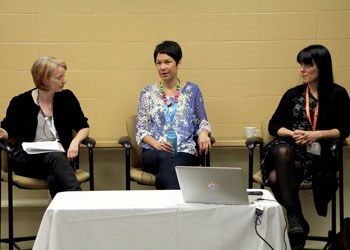There is a new wave of aboriginal filmmaking both in North America and the world. A panel at the Yorkton Film Festival brought together filmmakers Lisa Jackson and Michelle Latimer spoke about their experience being aboriginal filmmakers and about what is going on in the movement.
Jackson says that there is an indigenous scene that is growing, and she says that there is a sensibility and style growing in the movement. In particular, she cites the ImagineNATIVE film festival as example of how the community is coming together, with strong work and a great deal of effort put into finding and encouraging talent. She says the festival is great because of a combination of the quality of work, but also the community it is building, which has been instrumental in keeping filmmakers going and developing talent.
Jackson says that she believes some of the most creative and ground-breaking work is coming from the indigenous community, and that she says she has been blown away by many of the films she has seen through different festivals and programs.
Latimer agrees, saying that she believes it's a cultural difference, as the way stories are passed down through culture changes how people see the world, how people visualize narrative and even simply how stories are structured. She says that magical realism, for example, is an essential part of the stories of their culture, which changes how stories are told.
For that reason, Latimer says that there need to be more aboriginal trained story editors, so they understand the cultural differences. Jackson points to New Zealand as a place where their aboriginal filmmaking has had great success because there are Maori people on all levels of the funding chain. Jackson says she is appreciative of the support given, but that it is still not perfect.
Latimer says that technology has also been instrumental in engaging a new wave of aboriginal filmmaking. She notes that the ubiquity of cameras makes it possible for people in remote areas to make films where they otherwise would be unable to have access to tools to make films and tell stories.
"You're getting a generation now that is feeling empowered to make changes and get their work out there," Latimer says.
There are still challenges, and both admit that they have to push harder to be recognized as on the same level as their peers and not just products of programs designed to engage the community.
Latimer says that her perspective as an indigenous person is always going to be a vital part of her films, whatever the subject is, and she wants to be seen as someone whose perspective is valuable.
"I don't want to just be seen as an aboriginal filmmaker, I want to be seen as a filmmaker." Latimer says.
Making the leap to features is a challenge, the women agree, and both have known people who have been discouraged by being unable to push into features from success in short films. Latimer says that she is one of those people who wants to make that move into features, and she says she still feels excited when she sees a film in the theatre, and that is why she makes films.




